|
pdf
downloaded
from pjga |
|
Page 01 |
|
Page 01
Review n°
1454/09.5TVLSB.U.S1
The plenary
assembly, in
the Supreme
Court of
Justice,
ruled :
The
appellants,
Kate Marie
Healy McCann
and Gerald
Patrick
McCann,
after being
notified of
fls.2739 et
seq. of the
ruling,
argued at
fls. 2793 et
seq. before
the assembly
the nullity
of that
ruling,
under the
terms and
for the
purposes of
articles
615-1b/e, 4
and 666 of
the Civil
Procedure
Code.
The
respondent
Guerra e
Paz,
Editores,
SA,
answered,
concluding
that the
allegation
of nullity
had no
legitimacy.
The assembly
has to
decide, the
examination
of the
minutes
having been
dispensed.
The
appellants
claim a lack
of ground
for the
conclusion
reached by
the court
that the
principle of
the
presumption
of innocence
cannot be
called upon
in the
minutes to
restrict the
right to
freedom of
expression,
as the
starting
point was
the mistaken
assumption
that the
criminal
proceedings
were brought
to a close
because “the
Public
Ministry had
not been
able to
obtain
sufficient
evidence
concerning
the practice
of a crime
by the
appellants”.
They (the
appellants)
conclude
that the
defects of
contradiction
between the
factual
basis and
the
conclusions
reached in
the ruling,
as well as
the lack of
ground, must
be remedied.
Let's see.
According to
the
provisions
of articles
615-1b,
666-1 and
685 of the
CPC, the
ruling is
invalid when
it does not
specify the
factual and
legal
grounds for
the
decision.
Thus, what
the law
considers
null is the
absolute
lack of
motivation,
that is, the
total
absence of
legal and
factual
grounds.
Well, it is
obvious that
this is not
the case
here, since
the ruling
at stake
specified
those
grounds. |
|
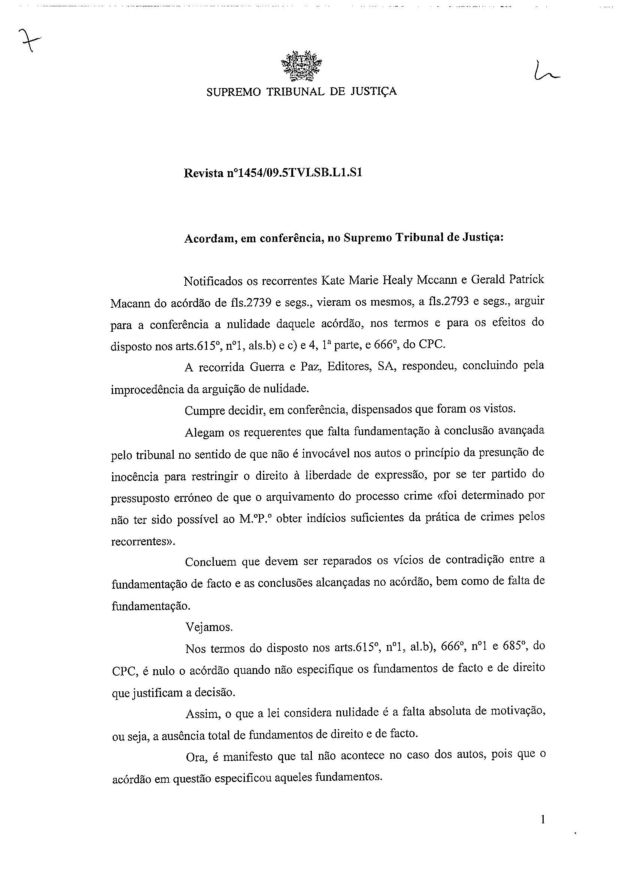 |
|
|
| |
|
Page 02 |
|
Page 02
Essentially,
what it is
all about is
the
appellants'
disagreement
with the
decision of
that ruling
and they
certainly
consider
that the
statement of
reasons is
wrong. This,
however,
does not
produce
nullity, it
can only
affect, if
it occurs,
the
doctrinal
value of the
ruling. On
the other
hand, under
the terms of
articles
615-1c
(first
part), 666
and 685 of
the CPC, the
ruling is
invalid when
the grounds
are in
opposition
to the
decision.
Here, it is
a ruling
which is
vitiated by
a logical
defect that
compromises
it, since
the grounds
relied on
therein
logically
lead not to
the result
expressed in
the decision
but to the
opposite
outcome. The
appellants
allude to
contradictions
vices
between the
factual
grounds and
the
conclusions
reached in
the ruling.
However, it
does not
appear that
there is any
contradiction
between the
grounds and
the
decision,
nor do the
appellants
point them
out with
rigour,
claiming
that this
happens when
the ruling
refers to
the
relationship
between
their rights
to good name
and
reputation
and the
presumption
of
innocence.
Let us see,
then, what
is said here
in that
respect :
First of all
it has to be
said that
the
principle of
the
presumption
of innocence
(art. 32°-2
of the CRP,
11°-1 of the
UDHR and
6°-2 of the
European
Convention
on Human
Rights) is a
rule of
treatment to
be given to
the arguido
(formal
suspect)
throughout
the judicial
criminal
process.
Accordingly,
this
principle
can not be
construed as
a
restriction
on public
discussion
of
potentially
criminal
facts,
despite that
public
bodies
should, in
their
communications,
resort to
the
necessary
reserve to
avoid
creating the
conviction
that the
arguido is
in fact
guilty (Cf.
Konstas vs
Greece of
28/11/ 11
(n°
053466/071).
That
referred
principle
may even
impose, on
the
threshold of
criminal
proceedings,
respect for
an
absolutory
penal
decision or
even for a
decision of
archiving by
the judicial
authorities
involved in
subsequent
proceedings
(Allen vs
United-Kingdom,
of
12/7/2013,
n°
1025424/0991) |
|
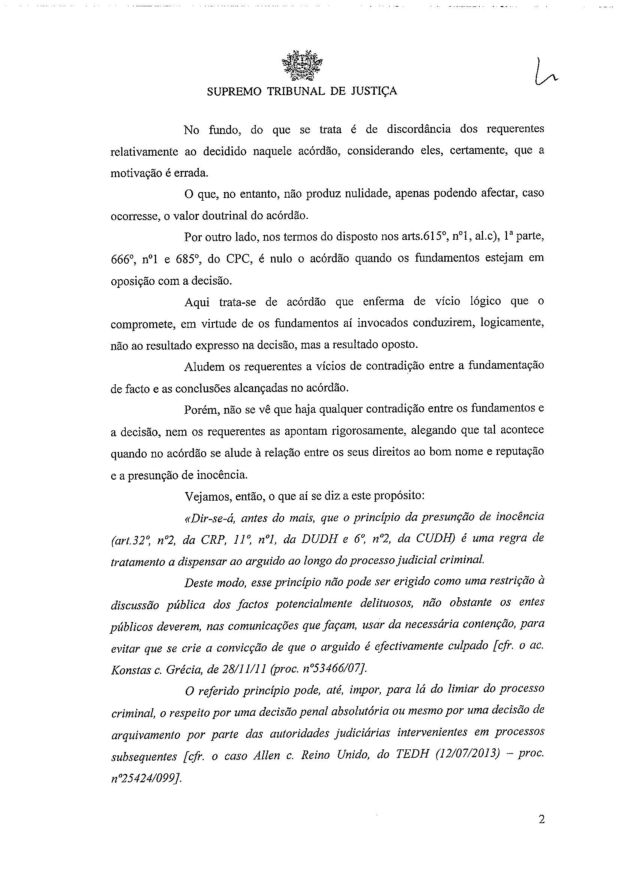 |
| |
|
|
|
Page 03 |
Page 03
Nevertheless, the
Court of
Justice of
the European
Union (CJEU) has
decided that
the principle
of
presumption
of innocence
does not
apply to
civil proceedings
(mainly
compensatory) subsequent to
a criminal
lawsuit, in
order not to
deprive the
victim of
their own
right to
accede to
the court
and
be compensated (Cf.
the rulings in
Y vs Norvvay
(56568/00)
of 11/
05/2003 and
Diacendo vs
Italy
(124/04)
of 05/07/2012).
As Jónatas
Machado
points out,
in "Freedom
of
Expression,
Public
Interest and
Public
Figures and
Equalities", BFDUC,
vol.LXXXV,
2009, p.
91, The
presumption
of
innocence,
because it's
only a
presumption,
cannot
overcome the
search for
the truth
and the
right of
citizens to
the truth.
It cannot as
well prevent
public
criticism
and public
scrutiny of
the
functioning
of justice.
The same
happens,
furthermore,
with the
attempt to
demonstrate
the
innocence of
a condemned
person and
thereby to
move aside
the mark of
the
conviction.
The search
for truth,
including
the truth
about
justice, has
always been
one of the
main
justifications
of freedom
of
expression.
It must be reminded that, in the present case, the
issue isn't
the
appellants'
penal
liability,
in other
words their
innocence or
their guilt
concerning
the facts
leading to
the
disappearance
of her
daughter
doesn't have
to be
appreciated
here.
What is in discussion here is merely the civil
liability of
the
respondents,
on the
grounds that
they have
expressed
and
disclosed
the
above-mentioned
thesis/opinion
on the
disappearance
in question.
It follows that the outcome of the present case is
not such as
to call into
question the
extra-procedural
dimension of
the
presumption
of
innocence.
This means that, even if the action does not
proceed, it
will not
imply, even
in the eyes
of the
community.
any
consideration
of the
appellants'
liability,
because such
outcome will
never will
be able to
be equated
to an
observation
of
respective
culpability
(cf. on this
topic the
judgements
Del Latte vs
Holland
(n°44760/98)
of 9/11/2004
and Cheena
vs Belgium
of
9/5/2016).
In addition, we are faced with a decision of filing
by the
Public
Ministry
which is
subject to
modification
through
various
ways. |
|
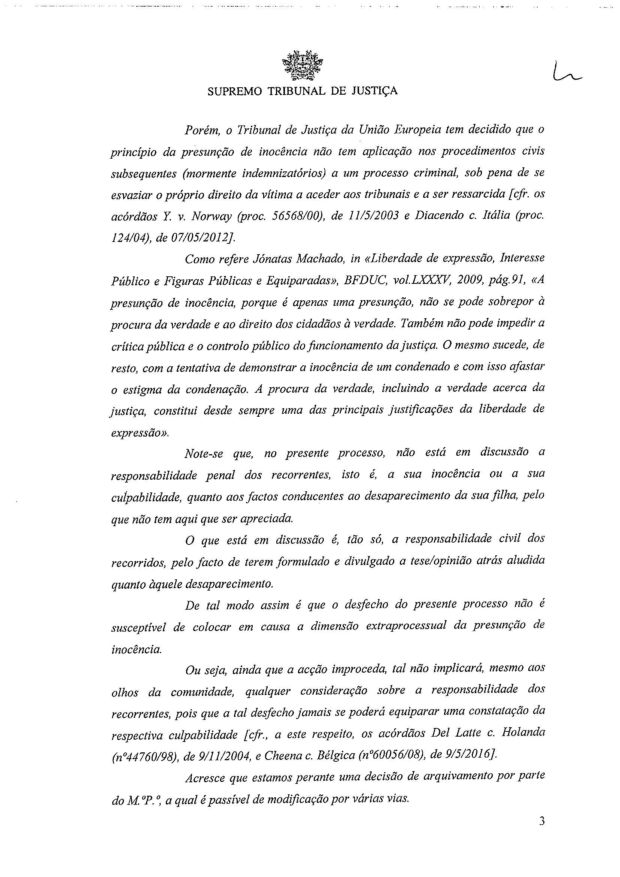 |
|
|
|
|
|
Page 04 |
|
Page 04
Thus, in
addition to
the recourse
to the
jurisdictional
way, by
opening the
inquiry
(art. 287 of
the CPP) and
the
complaint to
the
hierarchical
superior
(art. 278°
of the CPP),
the
investigation
can be
reopened if
new elements
of evidence
arise
invalidating
the grounds
called upon
by the
Public
Ministry in
the filing
dispatch
(art. 279 of
the CPP).
This is
indeed even
mentioned in
the Note to
the Social
Communication
released by
the Attorney
General's
office on
21/7/2008
and
announcing
that the
filing of
the
investigation
had been
decided. It
was reported
that it
could be
reopened on
the
initiative
of the
Public
Ministry or
at the
request of
any
interested
party if new
elements of
evidence
arise
triggering
serious,
pertinent
and
consequential
proceedings
(n°14 of the
proven
facts).
In this way,
as the
aforementioned
filing order
is not a
judicial
decision
stricto
senso, nor
does it
assume a
definitive
form, less
would it be
justified
invoking the
principle of
the
presumption
of innocence
to restrain
freedom of
expression.
And the
safeguarding
of the
authority of
the judicial
power (cf.
article 10-2
of the
European
Convention
on Human
Rights) is
not alluded
to, since is
definitely
outdated the
traditional
idea that
criticism
against the
judicial
power must
be
proscribed
as it
contributes
to the
undermining
of its
dignity,
authority
and
credibility
in the long
term. The
best
guarantee of
dignity of
all State
institutions
in the long
run consists
in its
permanent
opening to
public
criticism
(cf. Jónatas
Machado, Freedom
of
Expression -
Constitutional
Dimensions,
op. cit. pp.
566-7).
And let not
be said,
too, that
the
appellants
were cleared
by the order
of filing
the criminal
proceedings.
In fact,
that
dispatch was
not
proclaimed
by virtue of
the Public
Ministry
having
gained the
conviction
that the
appellants
had not
committed
any crime
(cf. art.
277 of the CPP).
The filing,
in this
case, was
decided
because it
was not
possible for
Public
Ministry to
obtain
sufficient
evidence of
the practice
of crimes by
the
appellants
(cf. the
cited art.
277-2)
There is,
therefore, a
remarkable
difference,
and not
merely a
semantic
one, between
the legally
admissible
grounds of
the filing
order. |
|
 |
| |
| |
|
Page 05 |
Page 05
Thus, it
does not
appear
acceptable
to consider
that the
alluded
dispatch,
based on the
insufficiency
of evidence,
should be
treated as
evidence of
innocence.
We consider,
therefore,
that the
invocation
of breach of
the
principle of
presumption
of innocence
should not
be upheld.
That
principle
does not
fall under
the decision
about the
question
that has to
be resolved.
Consequently,
the bases
for the
conclusion
that
invoking the
breach of
the
principle of
presumption
of innocence
should not
be upheld,
since that
principle is
not relevant
for the
decision at
stake, are
the various
grounds
alluded to
in the text
transcribed
above. In
other words,
what is
called upon
right from
the outset
is that this
principle is
a rule of
treatment to
bestow upon
the
defendant
throughout
the criminal
judicial
process. At
present,
however, the
issue is
only the
civil
responsibility
of the
respondents.
The above
conclusion
does not
collide with
the grounds
on which it
relies.
It is not
the same to
disapprove
such grounds
and to
consider
that there
is an error
of judgment.
The
appellants
also allude
to the
thrust of
the Public
Ministry's
filing
order,
citing parts
of that
order set
out in point
15 of the
factual
matter. Let
us see,
nevertheless,
what this
point 15 is
made of and
also the
point 14,
related to
it :
14. On July
21, 2008,
the Attorney
General
office
issued a
"memorandum
for the
media"
announcing
that the
investigation
referred to
in paragraph
5 had been
closed and
that it
could be
reopened on
the
initiative
of the
Public
Ministry or
at the
request of
any
interested
party,
should new
evidence
arise that
could lead
to serious,
pertinent
and
consequential
proceedings
(article
209).
15. On July
21, 2008, an
order of
closure was
issued by
the public
prosecutor
concerning
the criminal
investigation,
recording
particularly
the
following:
"Taking into
account that
certain
points in
the
arguidos'
(formal
suspects)
and the
witnesses'
statements
revealed, at
least
apparently,
contradiction
or (...) |
|
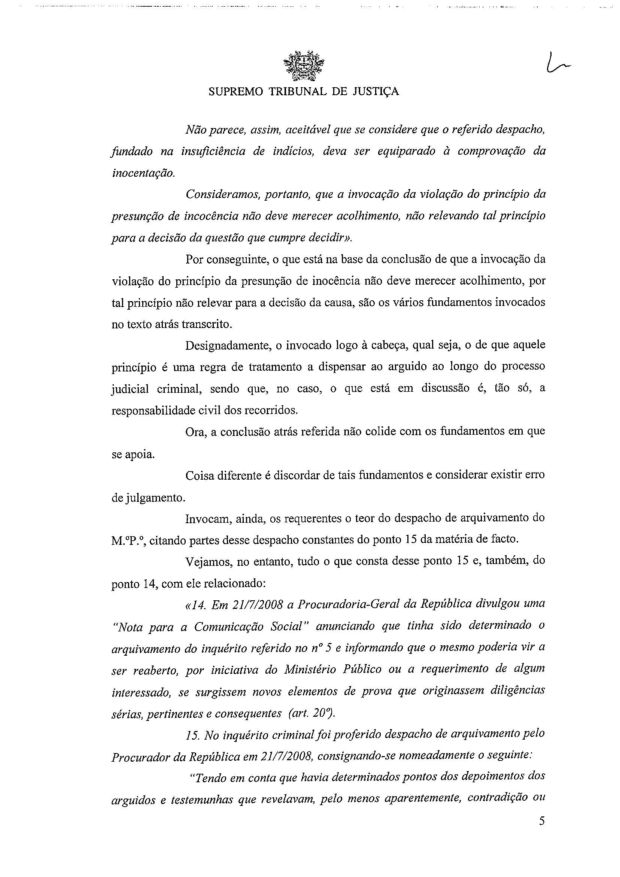 |
|
|
| |
|
Page 06 |
Page 06
(…)
lacked
physical
confirmation,
it was
decided to
carry out
the
"reconstitution
of the
fact", an
intervention
set up in
article 150
of the Penal
Process
Code, in
order to
duly
clarify, on
the very
location of
the facts,
the
following
crucial
details,
among others
:
1 - The physical, real and effective proximity
between Jane
Tanner,
Gerald
McCann and
Jeremy
Wilkins, at
the moment
when the
first person
walked by
the other
two, and
which
coincided
with the
sighting of
the supposed
suspect,
carrying a
child. It
ensues
strangely,
in our
perspective,
that neither
Gerald
McCann nor
Jeremy
Wilkins saw
her (JT), or
the alleged
abductor,
despite the
exiguity of
the space
and the
peacefulness
of the area;
2 - The situation concerning the window of the
bedroom
where
Madeleine
slept,
together
with the
twins, which
was open,
according to
Kate. It
seemed
therefore
necessary to
clarify if
there was
any draught,
since
movement of
the curtains
and pressure
on the
bedroom door
are
mentioned,
which,
eventually,
could be
verified
through the
reconstitution;
3 - The establishment of a timeline and of an
effective
checking on
the minors
that were
left alone
in the
apartments,
given that,
if such
checking is
believed to
be as tight
as the
witnesses
and the
arguidos
describe it,
it would be,
at least,
very
difficult to
reunite
conditions
for the
introduction
of an
abductor in
the
residence
and their
posterior
exit, with
the child,
namely
through a
rather
narrow
window.
Furthermore
the supposed
abductor
could only
pass through
that window
holding the
minor in a
different
position
(vertical)
from the one
that witness
Jane Tanner
saw
(horizontal);
4 - What happened during the time lapse between
approximately
6.45/7 pm. -
the time at
which
Madeleine
was seen for
the last
time, in her
apartment,
by a person
(David
Payne)
different
from her
parents or
siblings -
and the time
at which the
disappearance
is reported
by Kate
Healy - at
around 10
pm.;
5 - The obvious and well-known advantages of
immediate
appreciation
of evidence,
or in other
words, the
fulfilment
of the
principle of
contiguity
of evidence
in order to
form a
conviction,
as firm as
possible,
about what
was seen by
Jane Tanner
and the
other
protagonists,
and,
eventually,
to dismiss
once and for
all any
doubt that
may subsist
concerning
the
innocence of
the missing
child's
parents. |
|
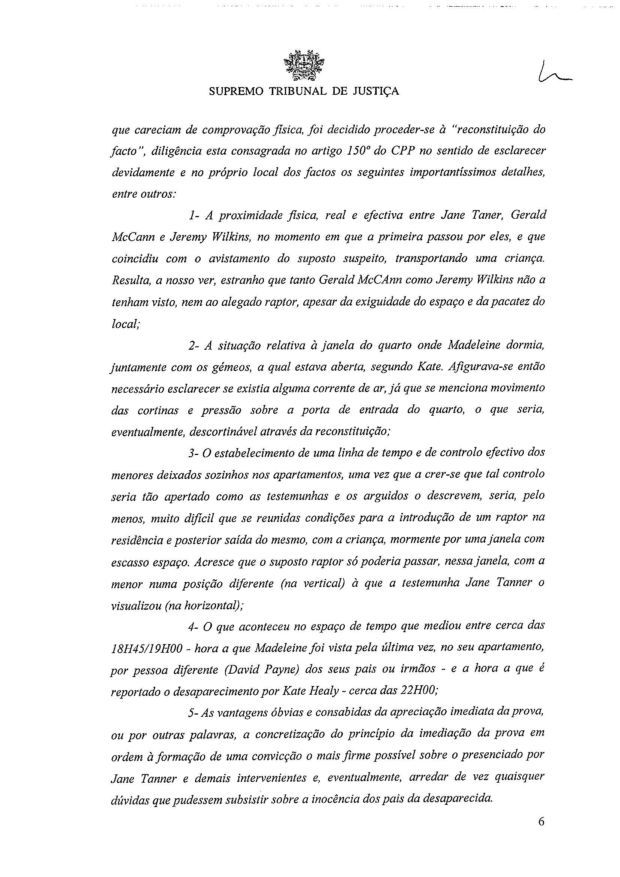 |
| |
|
Page 07 |
Page 07
To this
effect the
legal
procedures
were
followed
according to
the norms
and
conventions
that are in
force, and
the
witnesses'
appearance
was
requested,
inviting
them to be
present,
inclusively
appealing to
solidarity
with the
McCann
couple, as
it is
certain that
since the
beginning
they adhered
to that
process
intervention.
Nonetheless, despite national authorities assuming
all measures
to make
their trip
to Portugal
viable, for
unknown
motives,
after
raising many
doubts about
the
necessity
and
opportunity
of their
trip that
were
clarified
several
times, they
chose not to
attend,
which
rendered the
intervention
inviable.
We personally believe that the main damage was
caused to
the McCanns,
(then)
arguidos,
who lost the
possibility
to
demonstrate
what, since
they were
constituted
arguidos,
they have
been
protesting :
their
innocence
towards the
fateful
event ; the
investigation
was also
disturbed,
because said
facts have
still to be
elucidated.
(...)
This shows that the parents were not persistently
worried
about their
children,
that they
didn't check
on them like
afterwards
they
declared
they did,
rather
neglecting
their duty
to guard
those same
children,
although not
in a
reckless, or
gross,
manner.
(...)
While it is an inescapable fact that Madeleine
disappeared
from the
apartment 5A
of the
'Ocean
Club', the
manner and
circumstances
under which
this
happened are
not -
despite the
numerous
interventions
deployed to
this effect
-, therefore
the range of
crimes that
were
indicated
and referred
to during
the
investigation
remains
changeless.
(…)
Concerning the other indicated crimes, they are no
more than
that and
despite our
perception
that, due to
its high
degree of
probability,
the
occurrence
of a
homicide
cannot be
discarded,
such cannot
be more than
a mere
supposition,
due to the
lack of
sustaining
elements in
the minutes.
It seems that the objective circumstances of
Madeleine's
parents,
arguidos,
not being
inside the
apartment
when she
disappeared,
the normal
behaviour
that they
adopted
until said
disappearance
and
afterwards
lead to
their non
involvement
in any
penally
relevant
action, as
can be amply
concluded
from the
witness
statements,
from the
telephone
communications
analysis
and... |
|
 |
| |
| |
|
|
Page 08 |
Page 08
… also
from the
experts'
conclusions,
namely the
reports from
the FSS and
from the
National
Institute
for Legal
Medicine.
Moreover, in fact none of the clues that led to
their
constitution
as arguidos
happened to
be later
confirmed or
consolidated.
So let us
see: the
information
concerning a
previous
alert of the
media before
the police
forces was
not
confirmed,
the residues
marked by
the dogs
were not
corroborated
in
laboratory,
and the
initial
indications
from the
above
transcribed
email,
better
clarified at
a later
date, ended
up revealing
to be
innocuous.
Even if, hypothetically, one could admit that Gerald
and Kate
McCann might
be
responsible
over the
child's
death, it
would still
have to be
explained
how, where
through,
when, with
what means,
with the
help of whom
and where to
they freed
themselves
of the body
within the
restricted
time frame
that would
have been
available
for them.
Furthermore
their daily
routine
until May 3
had been
circumscribed
to the
narrow
borders of
the 'Ocean
Club' resort
and to the
beach
nearby,
unknowing
the
surrounding
terrain and,
apart from
the English
friends that
were with
them on
holiday
there,
having no
known
friends or
contacts in
Portugal.
(...)
Tests and analyses were performed in two of the most
prestigious
and
credentialed
institutions
for purpose
- the
National
Institute
for Legal
Medicine and
the British
lab Forensic
Science
Service -,
the findings
of which did
not
positively
assessed the
collected
residues, or
corroborated
the canine
markings;
It has not been possible to obtain any piece of
evidence
that would
allow for a
average man,
under the
light of
logic
criteria, of
normality
and of
experience's
general
rules, to
formulate
any lucid,
sensate,
serious and
honest
conclusion
about the
circumstances
under which
the child
was removed
from the
apartment
(...), nor
even to
produce a
consistent
prognosis
about her
destiny and
inclusively
- the most
dramatic -
to establish
whether she
is still
alive or if
she is dead,
as it seems
more likely.
Therefore, after all seen, analysed and duly
pondered,
facing what
is left
exposed, it
is
determined
(…)
The archiving of the process concerning the arguidos
Gerald
Patrick
McCann and
Kate Marie
Healy, as
there are no
indication
of their
practice of
any crime
(al. AO) . |
|
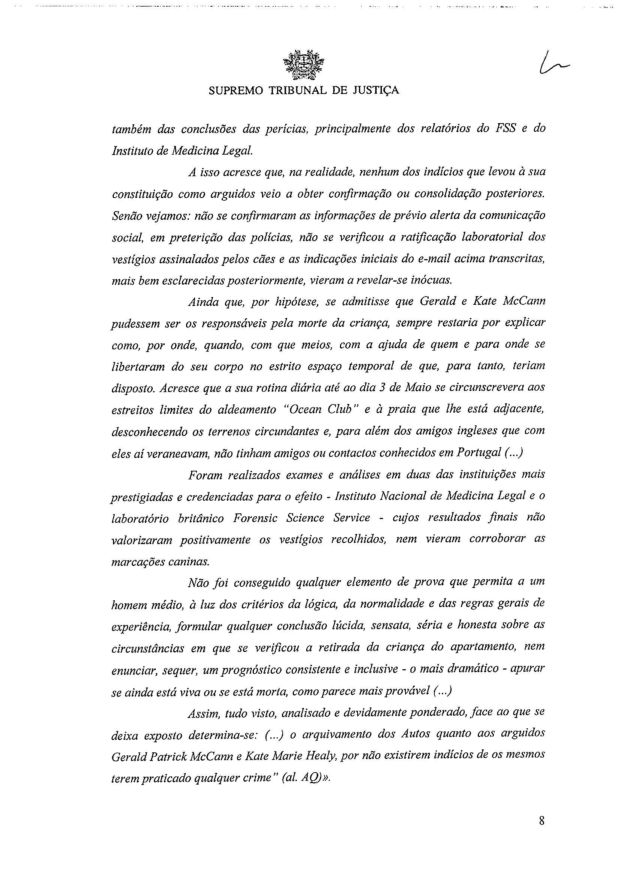 |
| |
|
| |
|
|
Page 09 |
Page 09
With regard to the wording in the filing order's transcription, the text
of the ruling pp. 66-67 says the following:
It is true
that the
criminal
investigation
was
eventually
closed, in
particular
because none
of the clues
which led to
the
constitution
of the
appellants
as arguidos was
subsequently
confirmed or
consolidated
(n°15 of the
proven
facts).
However,
even in the
filing
dispatch
serious
reservations
are raised
as to the
likelihood
of the
allegation
that
Madeleine
had been
abducted, in
view of the
doubts
raised by
the Jane
Tanner/Kate
McCann
version.
The
investigation
intended to
see
clarified
those doubts
by the
reconstitution
of the
events
mentioned in
the closing
dispatch, an
initiative
however that
was made
unfeasible
by the
witnesses'
failure to
appear after
being
summoned to.
In the said order, it was concluded also that the appellants had
neglected, although not recklessly or grossly, the duty of custody of
their children, and still that, although it had not been possible to
determine if the child was alive or not, it seemed more likely she
was dead.
The
appellants
alluded to
the
“ostensible
contradiction
of grounds”
because the
ruling held
that the
closure of
the criminal
proceedings
was
determined
since it had
not been
possible for
the Public
Ministry to
obtain
sufficient
evidence of
the
commission
of crimes by
the
appellants,
whereas the
filing order
states that
it occurred
"because
there were
no
indications
that the
appellants
had
committed
any crime,
in
accordance
with the
provisions
of article
277-1 of the
CPP". First
of all, let
us say that
the nullity
pleaded
consists in
contradiction
between the
grounds and
the decision
and not
between the
grounds. In
any case, it
will always
be said that
the alleged
contradiction
does not
exist
because, in
our view,
although the
filing order
refers to
the
provisions
of article
277-1 (note
that the
point 15 of
the proved
factual
matter makes
no reference
to that
article),
what is
pertinent is
the content
of the order
and not a
quoted legal
provision.
Now what is
obviously
underscored
in that
order is
that it was
not issued
because the
Public
Ministry had
been
convinced
that the
appellants... |
|
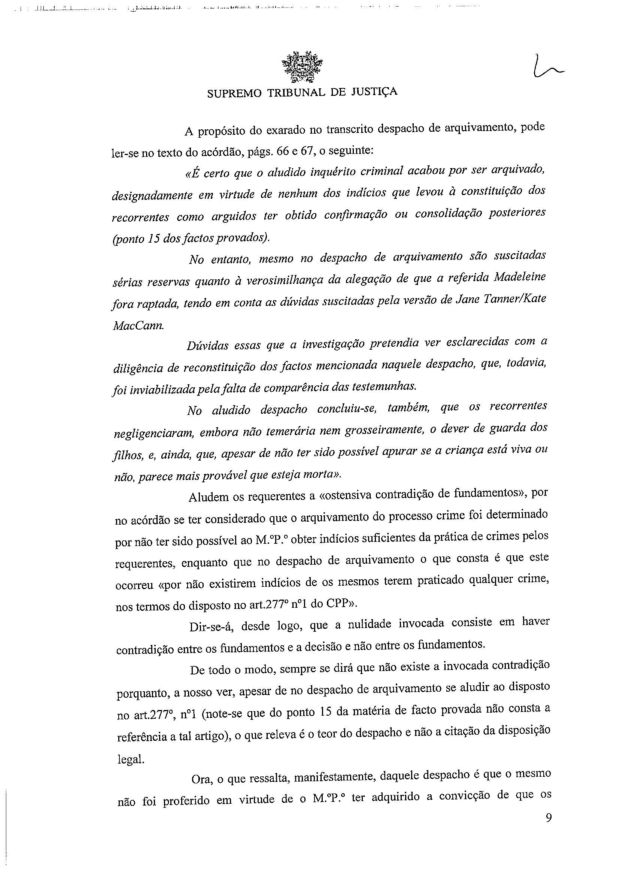 |
|
|
|
|
|
|
Page
10 |
Page 10
… did not
commit any
crime but
because it
had not been
possible for
the Public
Ministry to
obtain
sufficient
evidence of
the
commission
of crimes by
the
appellants.
It means that the archiving would have been determined
under
article
277-2 of the
CPP, and not
under the
first
paragraph of
that
article,
although the
latter is
quoted in
the order.
This is why it was judged in the ruling that it would not
seem
acceptable
to consider
that the
order should
be treated
as a
demonstration
of
acquittal.
In fact,
it does not
appear
anywhere in
the order, that the collected evidence was
sufficient
to confirm
that no
crime was
committed or
that the
then
arguidos
(here
appellants)
did not
commit it in
any sort of
way (cf.
quoted
article
277-1).
The fact that the aforementioned “memorandum for the
media”,
published by
the Attorney
General
office on
the same day
as the
filing
order,
informed
that the
investigation
could be
reopened “if
new evidence
arose that
could lead
to serious,
pertinent
and
consequential
proceedings”,
precisely
points out
that the
order was
issued
pursuant to
article
277-2 of the
CPP.
In fact, if the investigation had been closed according to
the terms of
the first
paragraph of
the same
article, it
could not be
reopened
(cf. CPP,
reviewed,
2016, 2nd
ed., by
Henriques
Gaspar,
Santos
Cabral, Maia
Costa,
Oliveira
Mendes,
Pereira
Madeira and
Henriques da
Graça,
pp.929,
932-3.
Anyhow, the intention was only to counter the appellants'
assertion
that, with
the
aforementioned
order, it
had been
demonstrated
that they
were
innocent.
Thus, in one form or another, whatever the grounds for the
closure of
the
investigation
and the
preclusive
effects of
the
respective
decision
(that has
not the
value of
res judicata,
which refers
exclusively
to decisions
of a
judicial
nature, but
is a
“decided
case” or
“close to
res judicata”
- cf. op.
cit. pp. 929
and 932), we
would always
consider
that the
public
criticism
and the
public
scrutiny of
the
functioning
of justice
were not
impeded, as
stated in
the ruling
in question.
That is to say, we would always conclude that the
presumption
of innocence
principle
would not be
pertinent
for the
decision on
the issue
that we had
to resolve. |
|
 |
|
|
|
Page 11
We have
therefore to
conclude
that the
ruling is
not
invalidated
by the
nullities of
article
615-1b,c of
the CPC,
applicable
through the
combined
provisions
of articles
666-1 and
685 of the
same Code.
In the light
of the
foregoing,
the filing
of nullities
of fls 2793
et
seq. is dismissed and the appellants condemned at the expense of the
incident
which they
gave rise
to.
Lisbon,
21.03.2017
The
document is
signed by
the three
same
magistrates
who signed
the
31.01.2017
ruling.
Jorge Manuel Roque Nogueira, Alexandre Reis and Pedro Lima
Gonçalves
|
|
|
Page
11 |
|
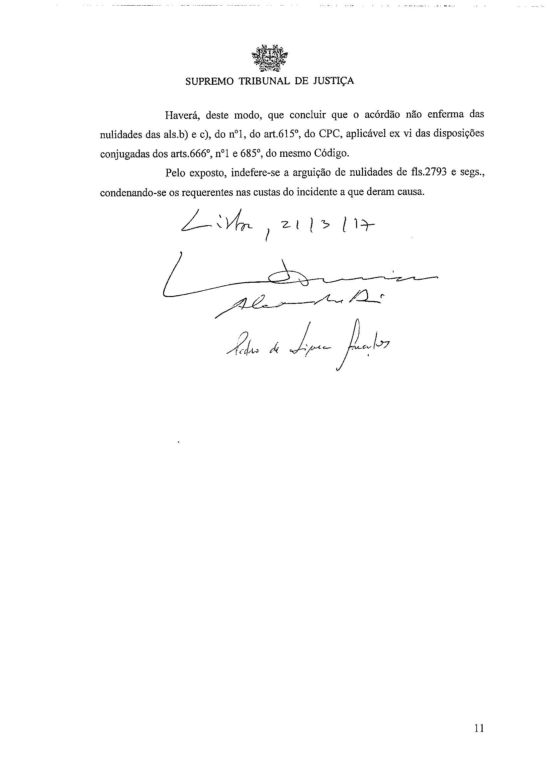 |
|
|
|
 |
|












